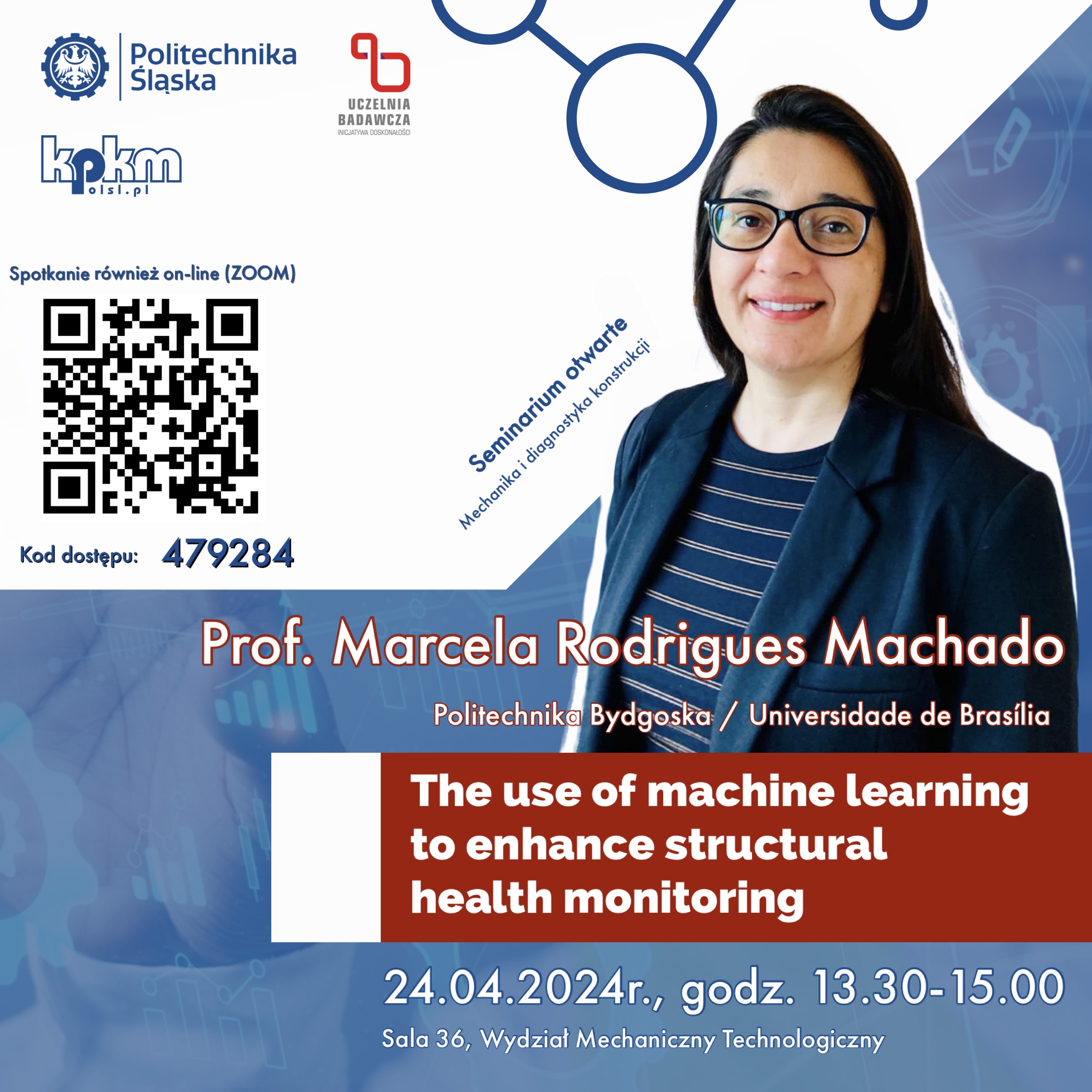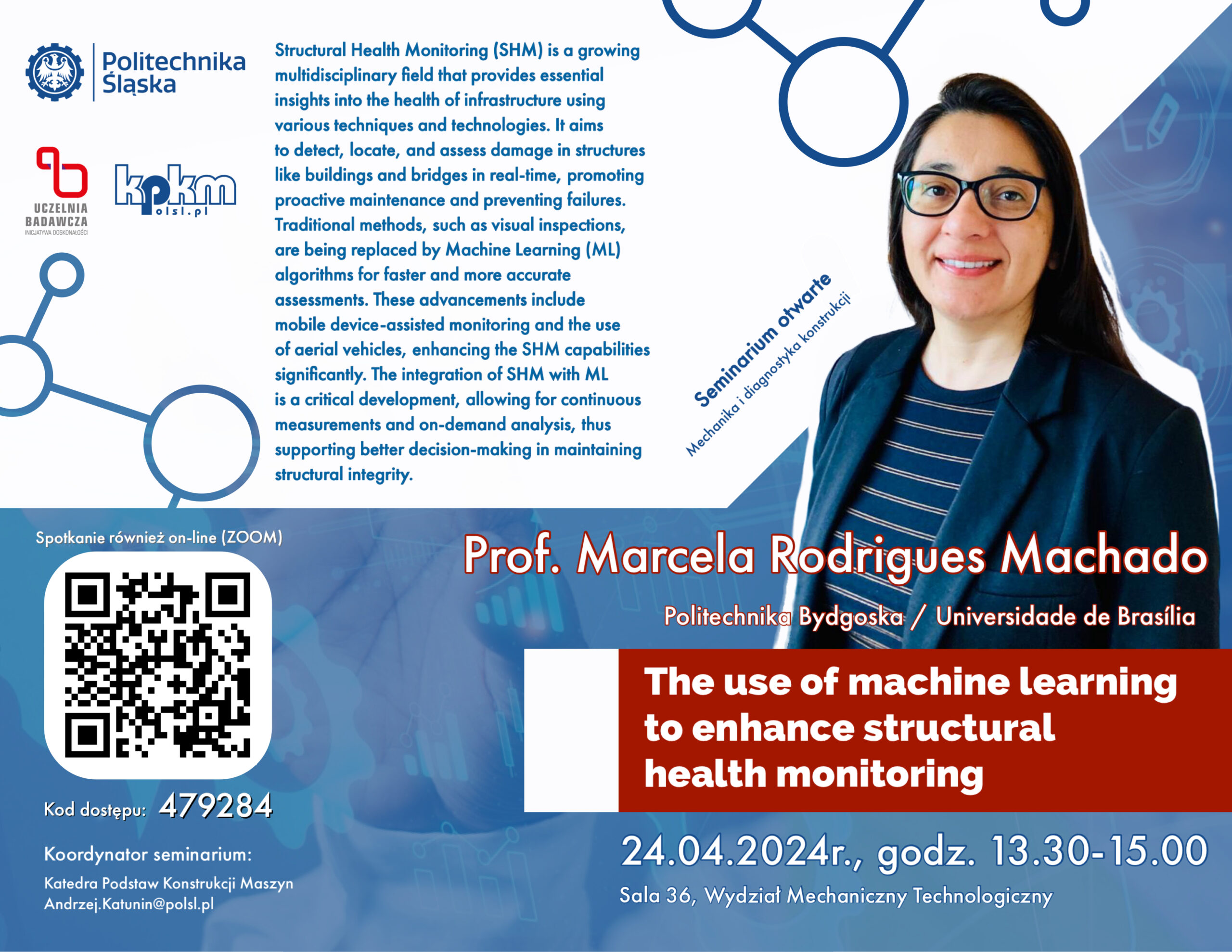
Seminarium naukowe nt. uczenia maszynowego w monitoringu strukturalnym
Dołącz do nas i weź udział w kolejnym seminarium naukowym poświęconym zagadnieniom monitorowania struktur (Structure Health Monitoring, SHM) i uczenia maszynowego (Machine Learning, ML)![]()
Odkryj, jak zaawansowane technologie i algorytmy ML rewolucjonizują sposób, w jaki monitorujemy i utrzymujemy naszą infrastrukturę. Nie przegap okazji, aby być na bieżąco z najnowszymi trendami i innowacjami w dziedzinie SHM. Zarezerwuj swój czas już dziś! 🌐✨
Wykład otwarty pt.: The use of machine learning to enhance structural health monitoring, który wygłosi Prof. Marcela Rodrigues Machado z Politechniki Bydgoskiej im. Jana i Jędrzeja Śniadeckich i Universidade de Brasília, już w dniu ![]()
![]() .
.![]()
![]() .
.![]()
![]()
![]()
![]() o godzinie
o godzinie ![]()
![]() :
:![]()
![]() w sali
w sali ![]()
![]() (na Wydział Mechaniczny Technologiczny, Politechnika Śląska).
(na Wydział Mechaniczny Technologiczny, Politechnika Śląska).
Wykład również on-line (kod spotkania: ![]() 479284
479284![]() ):
):
![]() https://polsl-pl.zoom.us/j/91575958549
https://polsl-pl.zoom.us/j/91575958549
🎙️ Dr. sc. ing. Marcela Rodrigues Machado is Assistant Professor at the Department of Mechanical Engineering at the University of Brasília, Brazil since 2016. Additionally, she holds a position as a Research Professor at the Faculty of Civil and Environmental Engineering, Politechnika Bydgoska im. Jana i Jędrzeja Śniadeckich, since 2023-2025, where she leads the project “Design and Optimization of Smart Wind Turbines for Vibration Control and Structural Monitoring (SWinT)”. Her research interests lie in structural monitoring and control of dynamic structures. With 45 scientific publications abstracted in the Scopus database (h-index = 14), she has coordinated and participated in the implementation of several national and international projects under Brazilian and EU programs. Dr. Machado has also supervised undergraduate scientific projects, master dissertations, and doctoral theses, maintaining international collaborations with researchers from the United Kingdom, France, Poland, Italy, Portugal, India, the USA, and Brazil.
Streszczenie wykładu:
The multidisciplinary field of Structural Health Monitoring (SHM) has grown significantly over the years due to its ability to provide crucial insights into various systems and infrastructure conditions. It encompasses multiple techniques and technologies to continuously monitor the structural integrity of buildings, bridges, dams, pipelines, machinery, aircraft, and other critical infrastructure assets. The primary goal of SHM is to detect, locate, and assess structural damage or deterioration in real-time or near real-time, enabling proactive maintenance and preventing catastrophic failures. Therefore, traditional methods of structural assessment, such as visual inspections and periodic testing, are often time-consuming and costly and may not provide comprehensive insights into the structural health over time, thus highlighting historical inefficiencies in monitoring frameworks. Consequently, conventional SHM techniques are undergoing a transformative shift towards real-time and online damage assessment by leveraging Machine Learning (ML) algorithms to enhance SHM capabilities, offering intelligent solutions to longstanding challenges. Recent breakthroughs in mobile device-assisted monitoring, aerial vehicles, virtual/augmented reality, and digital twins underscore the evolving landscape of SHM-ML integration. By bridging the gap between offline damage identification and real-time assessment, the integration of SHM with ML emerges as a vital strategy. This integration is facilitated by continuous measurements, feature extraction, and on-demand analysis and supports decision-making processes.
Zapraszamy![]()









